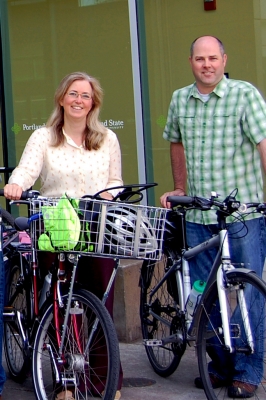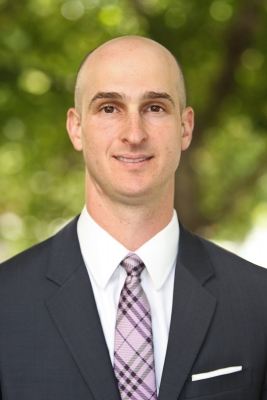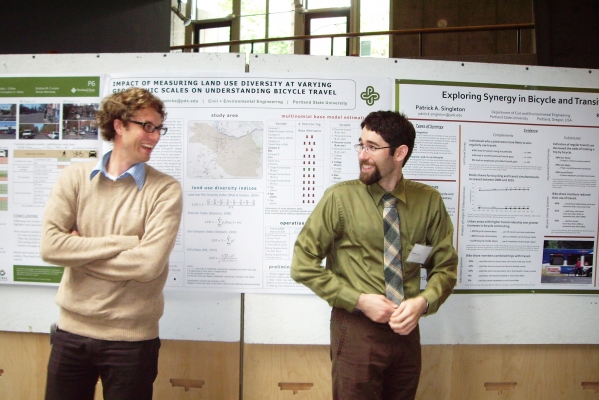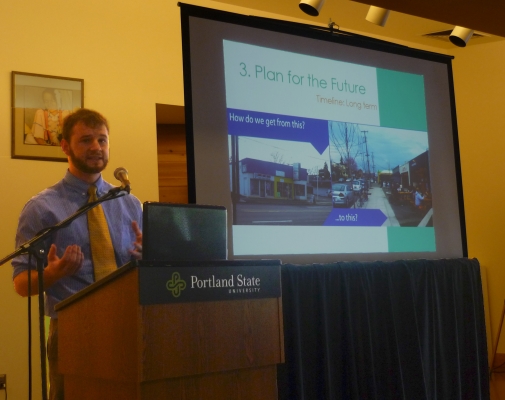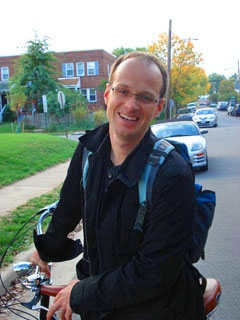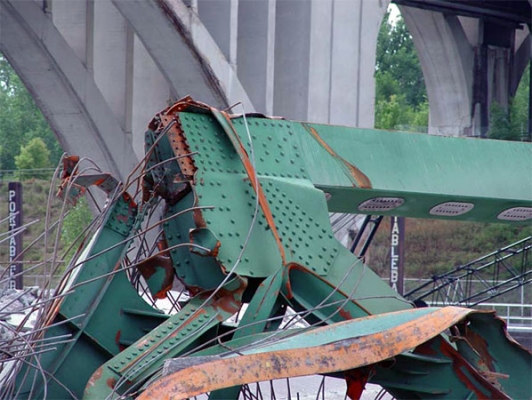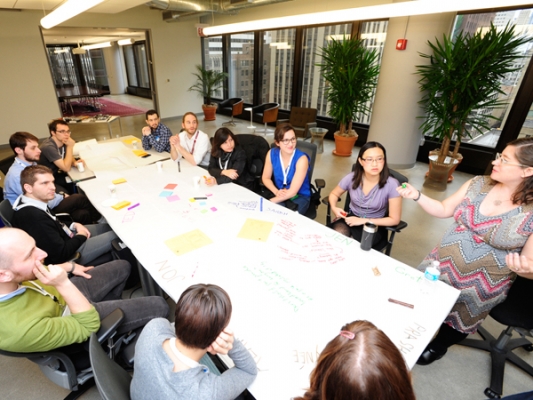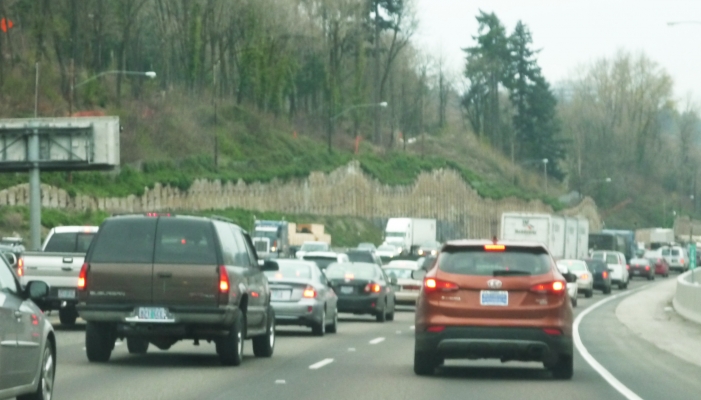The 2013 Oregon Transportation Summit will take place this fall, on September 16 at Portland State University. The summit brings together transportation professionals to shape the agenda for future research, and this year's plenary speaker addresses new federal legislation which will have a direct affect on that agenda.
Adie Tomer of the Brookings Institution will deliver the remarks at the summit's morning plenary session. The topic is MAP-21, a new act which was passed by Congress in 2012. Short for "Moving Ahead for Progress in the 21st Century," the act redistributes the scope and responsibilities of transportation departments at all levels, from municipal to federal.
"What MAP-21 essentially did is, it enhanced the evolution that's available within the federal program," Tomer said. "Because it is an overarching policy, it touches on every actor in the system in a unique way." For example, "MPOs (Metropolitan Planning Organizations) are now tasked with collecting performance measurements ... and state offices are pushed to do a little more planning when it comes to freight."
Portland, Oregon is known for being a bike city, even called America's Best Bike City by Bicycling Magazine, so it's no surprise at all that Portland State University is full of bike enthusiasts.
Sirisha Kothuri, an OTREC scholar for the past two years and a current Ph.D. candidate at Portland State University, has been awarded one of NITC'S 2013 dissertation fellowships.
The $15,000 fellowship -- funded through an ISS (Institute for Sustainable Solutions) grant -- along with an $800 OTREC/NITC scholarship for the 2012-2013 academic year, will assist Kothuri with her research into pedestrian signal timing.
Sirisha was born and raised in Hyderabad, India, and still misses the heat — or at least, the warmth; she has yet to become completely acclimated to Portland, Ore weather. In Hyderabad she obtained a bachelor's degree in Civil Engineering from Osmania University in 1999. She moved to Baton Rouge, Louisiana in 1999 to get a Master’s degree in Civil Engineering at Louisiana State University.
A visit to Illinois for her brother's graduation opened her eyes to the automobile-centric cities that make up much of the United States. She was surprised at some of the infrastructure in the Midwest, which decidedly favors cars over pedestrian and other means of active transport.
Walking plays a significant...
Read moreOTREC at Portland State University is pleased to announce the 2013 OTREC/NITC scholars.
Each year, OTREC and NITC recognize outstanding students, awarding them scholarships to further their work on transportation projects.
This year's scholarship winners tackle a range of projects, including long-range visions on how to improve equity in transportation, plans for proposed facility upgrades at specific locations, investigations into new ways to strengthen pavement, and the development of advanced technologies to assist the flow of transportation in the real world.
Each year, Portland State University’s MURP, or Master’s of Urban and Regional Planning, program hosts a public presentation to showcase the work of its graduating master’s students. Students who graduate with a Master’s in Urban and Regional Planning spend the last two terms of their program collaborating on workshop projects, completing planning tasks for local clients or business organizations.
This year’s presentations took place on Wednesday, attended by a crowd of about a hundred PSU students, professors, MURP clients and community members. Six groups presented their projects. Some of the projects were transportation-focused, especially one titled "Lombard Re-Imagined."
Swift Planning Group, composed of members Kathryn Doherty-Chapman, Zef Wagner, Brian Hurley, Jake Warr, Rebecca Hamilton, and Jodi Jacobson-Swartfager, developed a plan to improve Lombard Street, a key transportation corridor in North Portland.
The challenge facing the group had to do with the many roles that Lombard street plays. The street is both an arterial throughway and a state highway. It is an overdimensional freight route, for trucks that are too big to go anywhere else in North Portland, and it has also been designated as a main street in Metro’s 2040 Growth Concept. The various...
Read moreWhat makes Americans’ travel behaviors so different from that of their West European counterparts? Longer trip distances? Higher rates of licenses and auto-ownership? A culture and economy that depends on the automobile industry? According to visiting scholar Ralph Buehler, none of these explain the differences in mode splits.
In partnership with Students in Transportation Engineering and Planning (STEP), Portland State University recently hosted visiting scholar Ralph Buehler at the Friday Transportation Seminar series. Dr. Buehler traveled west from Washington, D.C. where he is an Assistant Professor in Urban Affairs and Planning at Virginia Tech’s Metropolitan Institute. Dr. Beuhler’s research and expertise is in multimodal planning and travel behaviors, with a focus on Western Europe and North America.
Click here to view the webcast.
Dr. Buehler’s presentation, titled “Making Urban Transport Sustainable: Comparison of Germany and the US,” poked holes in many of the common theories explaining why Americans are more likely to use their cars for all their travel needs. Instead, he noted that, “transport policies have to explain the difference [in mode shares] over time, including the changes that have happened in Germany and those that have not happened in the US. ” His research has led him to identify four major policy...
Read moreAn OTREC research project recently took a look at gusset plate connections, the riveted plates of sheet metal that hold steel truss bridges together.
These connective plates have come to the attention of the Federal Highway Administration (FHWA), because in 2007 the collapse of the Interstate-35W Bridge in Minneapolis was the result of a failed gusset plate.
After the collapse, which killed 13 people and injured 145, the FHWA issued a set of guidelines for load rating — or determining the weight-bearing capacity — of gusset plates.
Historically, only bridge truss members were considered for load rating during safety inspections. Gusset plates were thought to be reliable based on conservative assumptions employed during their design.
For more details, visit the project page.
Roughly 20,000 steel bridges in the United States are classified as non-load-path-redundant, or fracture critical, bridges. This means that the failure of a single truss member or connection could lead to collapse.
The problem, says the project's lead investigator Christopher Higgins, happens when a plate goes out of plane. It’s supposed to be perfectly flat, but with too much load put on it, it can develop a bifurcation and go from stable to unstable.
“It’s...
Read moreThe American Planning Assocation held its annual conference in Chicago this April.
Two OTREC universities sent students to attend, and OTREC staff member Jon Makler attended the Intelligent Cities "Unconference," which was held on Wednesday, April 17.
In addition to Portland State University graduate student research group Celillo Planning Studio, which won the APA student award for Application of the Planning Process, there were other PSU students who attended just to soak up the conference. Two students from the University of Oregon also attended and created a research poster for the conference.
This year's APA gave some focus to transportation. In addition to Monday, April 15 being themed "Transportation Day: Transforming Cities Through Transportation," there were also a handful of other transportation events including workshops titled "Sustainability Implications for Urban Transportation" and "Transportation Planning in a Changing Climate."
Makler, OTREC’s Education and Technology Transfer Program Manager, said that one of this year's highlights for him was the Unconference: a facilitated, participant-driven meeting which encouraged attendees to explore the ideas they were most interested in talking about. OTREC was one of about 25 organizations to take part in the Unconference.
...
Read moreWhen planning their daily commute, most drivers account for the traffic they know is unavoidable: at peak times of day, like morning and afternoon rush hour, they probably allow extra time to get where they’re going.
The delays that are harder to accept are the unexpected ones, when accidents, road work, or a traffic bottleneck turn a thirty minute trip into an hour.
This unpredictable postponement leads to natural frustration on the part of drivers, as it may cause them to be late to work or late picking up children from school. A reliable road network is one in which this is a rare occurrence.
A project led by Portland State University’s Miguel Figliozzi explored the value of this travel-time reliability using a study of commuters’ route choice behavior, taking a look at the trade-offs between reliability, traffic congestion, and air pollution.
The details for the combined project can be found here.
In the first phase of the research, co-investigators David Levinson and Kathleen Harder of the University of Minnesota sought to measure the route choices drivers made in a real-world setting. Instead of just having people fill out a survey about whether they would choose to take major roads or the freeway to work, this study ambitiously...
Read more
